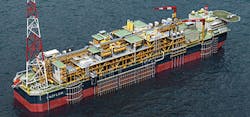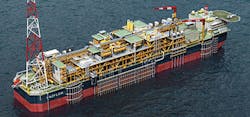PCM has introduced Deepwell pump technology to address fluid-handling issues during processing of hydrocarbons on FPSOs. Conventional centrifugal pumps, the company claims, are much less efficient at handling viscous or shear-sensitive fluids or at transferring fluids at the low flow rates needed for certain treatment processes on floating installations.
Deepwell is based on the progressing cavity pump (PCP) invented in 1932 by one of the company’s founders, Rene Moineau. Today’s design comprises two helical gears, one inside the other. The external gear (stator) is fixed while the internal gear (rotor) rotates around its own axis. The axes of the two components are parallel but offset from one another. An interference fit between the two creates a seal from one end of the assembly to the other. This seal line follows a helical path and creates a series of lenticular cavities that move in a spiral motion around the rotor as it turns.
During this pumping action the cavities maintain a constant shape and volume as they move, orprogress, along the pump conveying fluid from inlet to outlet. The flow rate depends on the cavities’ volume and rotational speed. According to PCM, this arrangement facilitates transference of highly viscous fluids or fluids containing solids, at the same time exerting low shear on the fluid mix.
Conventional Deepwell pumps used in process-related duties on FPSOs are adaptations of marine pumps typically used for cargo offloading, ballast, firewater and seawater lifting. They employ centrifugal technology, which involves applying energy to the pumped fluid via the vanes of an impeller rotating at high speed. However, fluids at elevated viscosities (50cP and above) induce high levels of friction between the fluid and pump impeller, leading to reduced pump efficiency and higher operating costs, PCM claims, because of high power consumption. And viscosities may vary from day to day, as the composition of reservoir fluids coming through the wells is not always predictable. The version of Deepwell adapted for these viscosities is said to provide greater hydraulic efficiency due to the lower internal leakage across the sealing line between the rotor and stator.
Another problem with centrifugal type Deepwell pumps in process applications is the high level of shear exerted on the process fluid. This is undesirable because it creates tight emulsions which then require additional processing on the FPSO topsides, when treating oil and water mixtures stored in the FPSO hull. The PCM Deepwell pump on the other hand transfers fluids gently, minimizing emulsion. This reduces topsides processing and leads to cost savings (less topsides weight and footprint and reduced chemical storage and consumption).
The PCM system comprises a dry, deck-mounted electric drive incorporating an EX-rated, low-voltage electric motor configured either for direct on-line operation for a fixed flow rate application, or for variation of the flow rate via a frequency converter (VSD). The motor is coupled to a helical gear reducer to limit the motor’s rotary speed from 1,500 to less than 200 rev/min, with torque transmitted to the main drive via a flexible coupling. This arrangement is said to lead to an energy-efficient, low noise pump system (max. 85dBA). A lubricated anti-friction roller bearing supports the combined axial load of up to 55kN (12,000 lbf) from the drive shaft and the hydraulic load from the pressurized fluid column inside the pump, while also allowing smooth rotation of the drive shaft.
“Because Deepwell pumps run so slowly, compared to centrifugal pumps, the vibration is reduced and this extends the lifespan of the pump and the seals,” explained Andy Boot, PCM’s Product Champion for surface transfer pumps.
An API 682-compliant double cartridge mechanical seal which provides high integrity sealing between the rotating shaft and the stationary part of the pump housing is above deck level, eliminating the need for system purging for testing. Below deck, the pipe stack (pump casing extensions) supports the stator assembly 30 m (100 ft) underneath, houses the drive shaft that transmits torque to the rotor and also conveys the pumped fluid which passes inside the pump casing. The drive shaft is maintained centrally inside the casing using purpose designed polyurethane centralisers. A connecting rod joins the drive shaft to the rotor, allowing it to rotate in an eccentric motion. According to Boot, this arrangement gives the pump more tolerance to different motions in the FPSO that cause deflections in the hull, while centrifugal pumps - with bearings inside the shaft line - are less tolerant.
The rotor is machined from a single section of high-strength steel with chromium plating to minimize the coefficient of friction between the rotor and stator and to maximize abrasion resistance and the rotor’s life.
One of PCM’s current orders is for a new type of offshore application west of Shetland in UK waters. Here the new FPSO for the Schiehallion and Loyal fields will be equipped with facilities to inject polymer emulsion into the reservoirs to enhance oil recovery. The polymer will be stored inside tanks within the FPSO hull and will have to be transferred under a pressurized feed via filters to high-pressure triplex pumps on the topsides prior to injection into the reservoir.
The polymer emulsion is extremely viscous: under high shear conditions the chemical is susceptible to damage that can impact the effectiveness of the EOR operation. This application is beyond the capabilities of centrifugal pumps, PCM says, which instead has engineered an 80-kW (107-hp) Deepwell pump capable of handling up to 120 cu m/hr (530 USgpm) of polymer emulsion.




